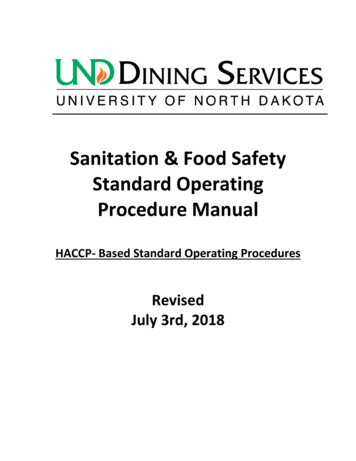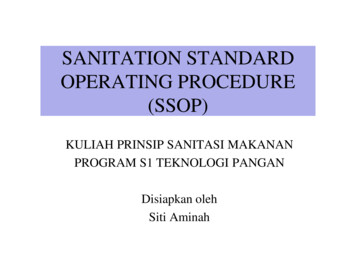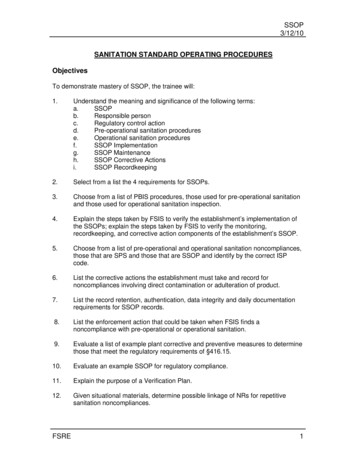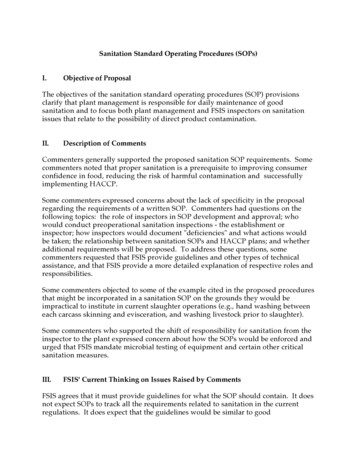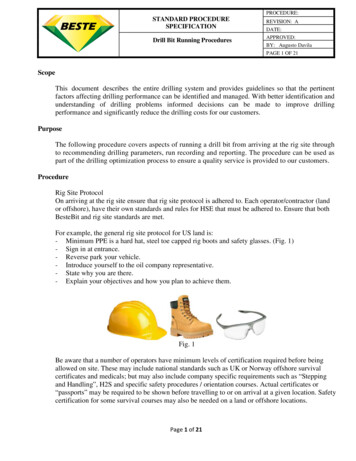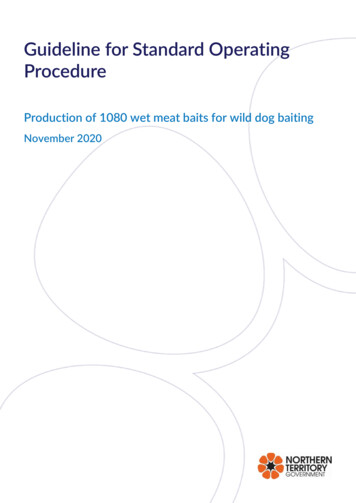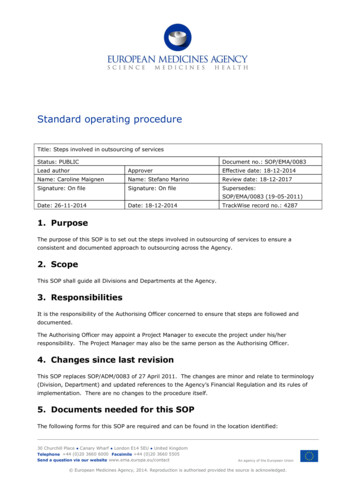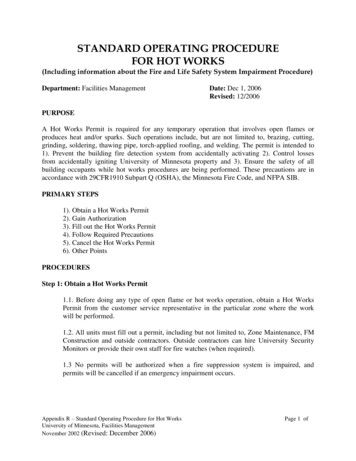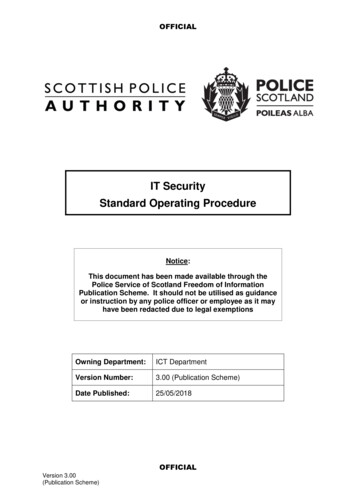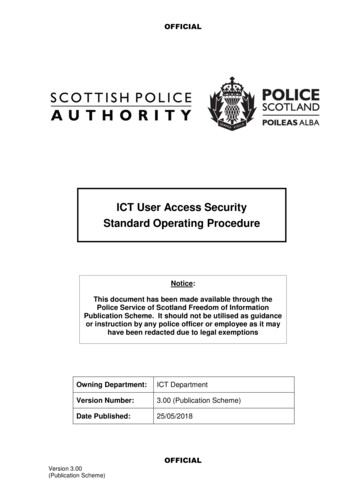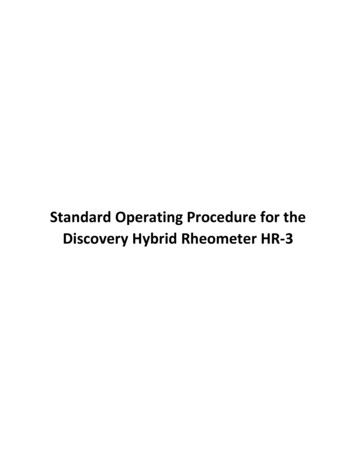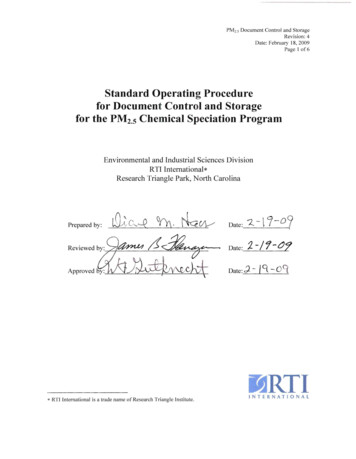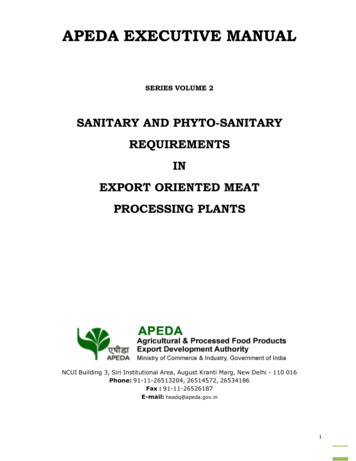
Transcription
APEDA EXECUTIVE MANUALSERIES VOLUME 2SANITARY AND PHYTO-SANITARYREQUIREMENTSINEXPORT ORIENTED MEATPROCESSING PLANTSNCUI Building 3, Siri Institutional Area, August Kranti Marg, New Delhi - 110 016Phone: 91-11-26513204, 26514572, 26534186Fax : 91-11-26526187E-mail: headq@apeda.gov.in1
CONTENTSPREFACEPage No.CHAPTER1.Premises of Abattoir51.1 Location1.2 Layout and Design of Abattoir/Meat Processing Plant1.3 Emergency Slaughtering1.4 Identification and Traceability1.5 Utility Services (Toilets, Canteen, Lockers, Laboratory, Guest House)1.6 Rendering Plant1.7 Effluent Treatment Plant2.Animal Welfare of Slaughter Animals103.Humane Slaughter134.Sanitation and Hygiene Requirements of Processing Units164.1Safety of Water4.2Cleanliness of Food Surfaces4.3Prevention of cross contamination4.4Hand washing sanitizing facilities4.5Proper labelling and storage4.6Exclusion of pest5.Equipment and Utensils216.Personnel Hygiene and Health requirements222
7.Processing of Meat23ChillingFreezingStorage8.Loading of Refrigerated Container249.HACCP, SO 9001:20082510. References32Annexure – IFlow Diagram333
PREFACEThe APEDA registeredforslaughterinintegrated meat processing plants receive the malsaretransported in a comfortable posture without any stress. Thereafter the animals arehandled carefully keeping in view their welfare, slaughtered humanely afterascertaining their fitness for human consumption both in ante-mortem and postmortem inspections by a competent veterinarian. The meat is then processed(chilled & frozen), stored and exported in refrigerated containers to the importingcountries.The meat plants are required to have APEDA registration and should conform to thesanitary regulations in the process of meat. The person handling the meat shouldconform to the sanitary and hygiene requirements for food safety as laid down in theExport of Raw Meat (Chilled / Frozen) (Quality Control and Inspection) Rules, 1992,and other standards as specified in this manual like GMP, GHP, HACCP, ISO9001:2008 and others. It is the responsibility of the Meat Exporter to ensure thatthese sanitary measures are adopted for production of safe meat. The InspectionTeam of APEDA drawn from different agencies, regularly monitor the safetyguidelines being practiced by the meat plants so as to instill confidence in the endusers.The meat slaughter (Buffalo, Sheep and Goats) for export has a unique value chainand is well organized right from livestock markets, transport of animals to theslaughter houses, production of finished product, transport of meat in refrigeratedcontainers to ports for shipment to importing countries. This manual has beenprepared to deal with all the quality and safety measures to be adopted forproduction of red meat including the minimum requirement of APEDA registeredabattoirs where animals are slaughtered.4
CHAPTER 1PREMISES1.1Location of AbattoirThe location of the abattoir where animals are slaughtered and meat is producedshould conform to BIS. The premises should be away from environmentally pollutedareas and industrial activities which produce obnoxious soot, dust, smoke, chemicalor biological emission and pollutants that pose a serious threat of contaminating themeat. The location should be free from floods, pests and where wastes, either solidor liquid, are dumped and can not be removed.The abattoir and processing plant should not be used for residential purposes andlivestock market.1.2Layout and Design of Abattoir /Meat Processing PlantThe layout of the abattoir and processing unit should permit Good HygienicPractices (GHP) including protection against cross contamination between andduring the operations. The activities in lairage, abattoir, processing, packaging andloading should be compartmentalized.The layout should have a bio-security built-in in the Plant where two zones shouldbe clearly demarcated namely, black zone and white zone. There should not be anycross movement of trucks/animals. The trucks carrying the animals for slaughtershould enter through the black zone where there is an arrangement for disinfectingthe truck tyres with 1% formalin so as to exclude the contamination entering intothe plant. The trucks carrying animals should never be allowed to enter through thewhite zone which is meant for exit of finished product only.There is always a forward movement of the animals. The animals are registered andtagged at the unloading area. Thereafter, animals are kept in the resting pens. Theresting pens should be covered. The capacity of resting pens including isolation pendepends upon the capacity of slaughtering per shift.The plant should have lairage, race, abattoir hall, slaughter lines, chillers, deboningand packing area, freezing and cold storage.5
-21.3Emergency Slaughter roomAn emergency slaughter room adjacent to the main abattoir to slaughter 8-10animals at any one time should be provided. Emergency slaughtering is done forinjured animals or animals escaped from confinement which might be of concern tothe workers employed in the plant. It has to be carried out in the emergencyslaughter room provided in the premises and may be carried out even beyond theworking hours in order to minimize the sufferings of the animal.1.4Identification and TraceabilityIdentification of animals has to be carried out as soon as the animals arrive at theslaughter house at unloading area for slaughter. This will create a preliminarytraceability system that will commence as soon as the animal arrives and is a firststep. Thereafter the traceability should be enforced at various stages, namely, antemortem, abattoir, post-mortem, chilling and processing hall with assigning the batchnumber.1.5Resting PensThe resting pens should be covered and provided with adequate supply of drinkingwater so that animals can rest after a stressful transportation. It is here that antemortem examination is carried out.1.6Isolation PenThe premises should have an isolation pen where suspected animals can be kept fordetailed examination.1.7Lairage and RaceA covered lairage and race have to be provided where animals are cleaned, washedand moved before slaughter.1.8Utility Services1. Suitable and adequate facilities should be provided to the workers employed inthe plant for changing their clothes, cleaning of their foot wear, hand glovesetc.6
2. Similarly adequate provision of toilets and change room should be made.Separate toilets, latrines and change rooms are provided for male and femaleworkers.3. Where five or more employees are working the following provisions are to bemade.Number of workersNot exceeding 25Between 25-49Between 50-100More than 100Number of latrines1235Number of wash basin12354. Adequate facilities for lockers be provided.5. Adequate facilities for canteen of workers and executive be provided.6. Facilities for prayer should also be provided.7. Hand sanitation station should also be provided where elbow and kneeoperated taps should be installed. Where paper towels are used, sufficientnumber of receptacles should be provided. Notices should be pasted at thewashing station.8. Laundry facilities for cleaning of workers uniforms should be provided.9. First aid and medical room for a part time medical doctor be provided for largeunits. For smaller units emergency call facility should be available.10.Adequate natural and artificial lighting should be provided throughout themeat processing. About 540 lux should be provided at all inspection points,about 220 lux in work room and 110 lux at other places. All bulbs should becovered and protected so as to avoid contamination of meat in case ofbreakage.11.Adequate ventilation should be provided to prevent excessive heat, steam,condensation and dust to remove the contamination. Ventilation openingsshould be provided with an insect screen or other protective enclosures ofnon-corrosive material.1.9Guest HouseThe premises may have a guest house where foreign delegation could stay with allthe arrangement for boarding and lodging. There should be a well maintained cleankitchen.7
1.10 LaboratoryThe in-house microbiological laboratory with sterilization room, media preparationroom, incubation room, laminar flow and washing room have to be provided to dothe microbiological examination of meat, water, air and personnel working in theplant.1.11 Rendering Plant - (Optional)Suitable capacity dry rendering/wet rendering plant to treat bones and non-edibleoffals should be provided in the premises to produce value added meat cum bonemeal and tallow for feeding poultry and soap manufacturing. This will also check thepollution in the plant. A No Objection Certificate from State Pollution Control Boardis mandatory requirement of APEDA for registration of plants and export of meat.1.12 Effluent Treatment PlantA suitable capacity effluent treatment plant needs to be provided to treat the effluentboth aerobically and anerobically to check the pollution. The effluent with 30 BODcan then be utilized either for in-house agriculture purposes or let into the farmersfield for growing crops.1.13 Lecture hall for in-house trainingFor in-house training of butchers, veterinary doctors and other skilled workers, aseparate lecture hall with black/green board be provided.1.14 Hide RoomA separate hide room where salting of hides is performed is to be provided dependingupon the capacity of the slaughter house.1.15 General StoreGeneral store should be provided to store all the products.8
1.16 Work shopThere should be a work shop for daily repairing and maintenance of the plant.1.17 Generator RoomThere should be a stand-by generator room for providing power during the breakdown.The premises should not be used for residential purposes. No personnel belongingslike clothing, bedding and shoe should be kept in the premises.No food should be allowed in the processing hall. Chewing of tobacco and smokingshould strictly be prohibited and notices to this effect be pasted at appropriatelocations.9
CHAPTER 2ANIMAL WELFAREAnimal Welfare is directly related with quality of meat production. The animalsshould be handled, transported, rested and slaughtered using humane practices. Ifthe animals are in stress, the quality and shelf life of the meat are affected.2.1Pre-Slaughter Handling of AnimalsAnimals for slaughter should be transported from farm/livestock markets in acomfortable posture as per the guidelines provided in prevention of cruelty towardsthe Animal Act of 1960 by providing adequate space in the vehicles and /or as perthe guidelines given by the Bureau of Indian Standards (2007). If the animals aretransported under stress by over loading then their body water and also the glucoselevel in the body muscles are reduced thus they fail to attain acidic pH while in thechillers affecting meat shelf life.The following requirements should be followed while transporting the animals fromfarm to slaughter house.1. Healthy animals free from diseases should be transported to the slaughterhouse. The animals meant for slaughter should be certified by a qualifiedveterinarian for their fitness to undertake the journey and their use as meatanimals.2. The transported animals should be in groups of preferably same sex and ageso as to avoid fighting due to their social behavior. Advanced pregnant animalsshould not be transported as they are not fit for human consumption.3. The vehicles should be thoroughly disinfected with a suitable disinfectantbefore loading the animals. Thereafter clean sand layer of about 6 cm shouldbe provided to prevent injuries to the animals. During summer it can bemoistened with water and in winter paddy straw may be used over the sandlayer.4. While driving the animals for loading / unloading stick should never be used.It can be done with soft rubber stick.5. During extreme weather conditions the animals can be transported in coveredvehicles so as to avoid extreme heat/cold.6. If the journey is more than 4 hours the animals should be properly wateredand fed.7. The trucks transporting the animals should not exceed the speed limit of 40km per hour so as to avoid jerks and injuries to the animals.10
2.2Loading and Unloading of AnimalsAnimals should be loaded on a ramp which should have a gradual slope and withanti-slippery device namely cleats at frequent intervals. It is better to have theseramps covered so as to avoid extreme weather condition.2.3Density of AnimalsBureau of Indian Standards (2007) and Ministry of Environment and Forest (2009)have given the following guidelines in their specification which have been adopted byAPEDA.Approximate floor space for transporting different classes of animals as per theMinistry of Environment and Forest notification 2009 is as follow :Number of CattleVehicle SizeLength xWidth(Sq Mtr.)Floor Areaof vehicle(Sq Mtr.)6.9 x 2.45.6 x 2.34.16 x 1.92.9 x 1.8716.5612.887.9045.481Weighingupto 200kg1 Sq.Mtr.161285200-300 Kg1.2 Sq Mtr.300-400 Kg1.4 Sq Mtr400 kgabove2 Sq Mtr.141064128648642For Sheep and Goats the following space requirement will be followed :Approximately weight ofanimals in KgUp to 20 Kg20-25 Kg26-29 Kg30-39 KgMore than 40 KgSpace required in Sq. Mtr.0.170.190.230.270.320.160.180.220.250.29The space requirements should be scrupulously followed while transporting theanimals.11
2.4RestingThe animals for slaughter are rested for 24 hours in pens where adequate water andshade are provided to alleviate the stress of the animals during their transportation.It is here that ante-mortem examination is carried out. The suspected animals arekept in the isolation pens where detailed examination is carried out by qualifiedveterinarian.The animals should be provided adequate space for resting namely 2 sq meters forlarge animals and 0.8 sq meters for sheep/goats.2.5Moving the AnimalsWhile moving the animals on race, the use of electric rods should be avoided. Theanimals can be moved with plastic sticks. The animal caretaker should
Sanitation and Hygiene Requirements of Processing Units 16 4.1 Safety of Water 4.2 Cleanliness of Food Surfaces 4.3 Prevention of cross contamination 4.4 Hand washing sanitizing facilities 4.5 Proper labelling and storage 4.6 Exclusion of pest 5. Equipment and Utensils 21 6. Personnel Hygiene and Health requirements 22 . 3 7. Processing of Meat 23 Chilling Freezing Storage 8. Loading of .
